- Title: Gal Pani X
- Platform: PC (Windows 95 or better)
- Developer: D5
- Released: 2000 (original demo version); 2002 (final release)
- Freeware PC game, not distributed in physical media
Introduction
Gal Pani X is a Japanese freeware PC doujin game from the early ’00s. This great game is perhaps the most unique Qix-style game I have ever played. It’s Qix, but crossed with a bullet-hell game, and with some key original additions I’ve never seen in any other game of this kind. However, it DOES have images of scantily-clad anime girls, so be warned. I won’t post that stuff here, but it’s in the game. If there are any naked images in the game I’ve never seen one, but there are plenty in their underwear and such. Unfortunately for anyone who doesn’t want to see that kind of thing, though, there is no other game out there I know of that plays like Gal Pani X. I wish there was, this game may be amazing but the visual theme is definitely not going to be for everyone. There’s no nudity in this game, but it definitely is quite NSFW due to the more suggestive images you can see if you play well.
The game is from the developer D5, a small doujin (indie) group who made only two games, this and Sispri Gauntlet, a super-hard Gauntlet-style game with Sister Princess characters in it. Gal Pani X is true freeware, while that one was sold, so the only free version is a two-level demo and the full game will prove very hard to find, I’ve never seen it myself. This review is about Gal Pani X, though, so on to the review. D5’s website was here: http://d5-dot.net/ but it’s offline now, sadly. Fortunately the game is still available for download online from other sites; remember, it’s freeware, so that is entirely legal. I link one site below, because all the others I found are “abandonware” sites full of retail titles for free download.
This is a PC game from the early ’00s, so it may have compatibility issues. The final game seems to be from 2002, though I also have an early demo version from 2000. The review below is for the final 2002 game. Note that this game is 4:3 and runs at 640×480; it didn’t auto-resize sometimes, on my newer computer, but the game is designed for that screen size. Also the game has some issues running on newer computers — on my current PC I can’t get the game to recognize my joystick, though it can see it just fine on my old WinME PC, and the framerate seems to stutter sometimes as well. I don’t know why. The game does play though, fortunately. If you are forced onto the keyboard as I am on my newer computer, Z is draw line, X is use bomb, and ESC opens the pause menu during play. Even on gamepad controls seem to just be digital, but work well enough.
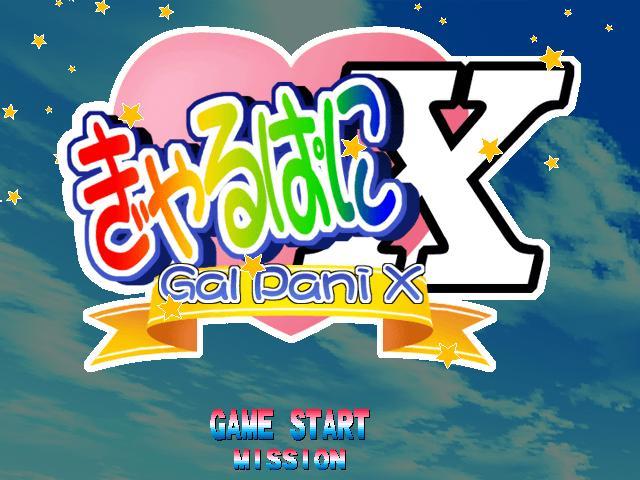
The title screen. The logo blatantly rips off To Heart.
Background
Qix is a classic arcade game from the early 1980s. The basic concept is that you control a small marker of some kind, and move around the edge of a screen with a vibrating line moving around the middle of the field. By holding the button, you can move into the field, and if you reach the edge again that line becomes the new border. However, if the line, called the Qix, or the Sparx moving around the edges of the field touch you, you die. The games’ later sequel Volfied, aka Ultimate Qix, adds small enemies in the field and adds easier difficulties where there aren’t enemies moving along the border you’re moving on. In either game you win by bordering off a set percentage of the screen, somewhere between 65% and 80% or so depending on difficulty.
Qix proved to be popular, and at some point in the late ’80s or early ’90s, somebody thought of the idea of making an adult arcade game using the basic gameplay concept. It was a somewhat natural combination — Qix is all about sectioning off a screen, so these games have you reveal a portrait of a naked or scantily-clad picture of a woman, either drawn in some games, or photos of real models in others. Many of these games have nudity in them, but some have only bikinis, underwear, and such. Perhaps the most popular series of this kind of game was Gals Panic. Gals Panic games were released for arcades, Saturn, and other platforms. There were many other similar arcade games, though, such as Miss World and such. I played this game before ever hearing about the Gals Panic series, or any of those other games, but that’s what the name references. This game has anime art and no nudity, just bikinis and underwear. I’m glad it doesn’t go any farther, it’s more than creepy enough as it is. This is a homebrew game though, of course, not an actual part of that series.
Then, starting in the mid 1990s, bullet-hell shooters rose to some prominence in Japan. These games are shmups, shooters where you fly a spaceship or flying person and shoot at things flying at you — but the hitbox, the number of pixels of your ship that actually kill you, shrank dramatically, sometimes to only one pixel. The most popular bullet-hell games are from the developer Cave, who made titles such as Dodonpachi, Mushihime-sama, and Death Smiles. In many of these games, the ‘beauty’ of the bullet patterns matters. Can you survive when the whole screen is full of patterns of bullets?
So, that is where we get to Gal Pani X. I first heard of this game because I watched, and really liked, the anime To Heart (the first To Heart series that is, not To Heart 2) back in the early ’00s, and at some point looked for PC fan-games about the series. This was by far the best such game I found, though there’s also a very mediocre To Heart doujin shmup out there. Gal Pani X takes the basic look of a Gals Panic game, but innovates the gameplay to such a degree that I think the games’ name is unfortunate; this game deserves its own name, not one inspired by what really is a very different series! Crossing Qix gameplay, freer movement (more on that soon!), and bullet-dodging makes for a unique and fantastic experience.

Stage two. Bullet patterns get tricky quickly. These folding enemies aren’t the hardest, but you do need to be careful while dodging them.
Basic Gameplay
Gal Pani X is a 2d game with fairly basic but nice-looking 2d graphics and a decently catchy MIDI soundtrack. It looks good, but certainly doesn’t push PC hardware of the early ’00s in any way. The game does play well though, and the controls are great and very responsive. In terms of gameplay, there are two key major differences between Qix as described above and Gal Pani X. Most importantly, unlike Qix, all Gals Panic games, Fortix, and all other Qix-style games I have ever played, in Gal Pani X you are NOT locked to the edge of the screen. Instead, you can freely move within the sectioned-off area of the screen! And second, all enemy fire can kill you at any time, unlike Qix where you could only die while trying to section off a part of the screen or if a Sparx hits you. In this game you have to watch out for, and dodge, bullets at all times; this is the bullet-hell element of the game. Oh, and you have a timer in each stage as well, so you need to get moving. These changes may sound simple, but together make for a fundamentally different game that plays incredibly differently from any other game in this sub-genre. I really, really love the free movement within the revealed part of the screen; after playing this game it can be hard to go back to regular Qix games where you can only move around the edge! Gal Pani X is an addictive game that I played for over 30 hours, which is a reasonably large amount for what is a pretty short game to finish if you just want to beat it once. And there is a lot more to find in this game, too, if you have the skill.
In the game you control a little diamond-with-a-circle-around-it sprite. You start in the center of the screen, in the middle of that random rectangle I mentioned. This is sort of the reverse of Qix, where you start on the edge of the screen and have to fill in the center; here you start in the center and have to fill in the outside. In each stage in the game, you start out in the center of the screen in a randomly-sized rectangle. A boss enemy will be somewhere on the screen outside of the box, along with some smaller regular enemies. The boss enemies and regular enemies are very cutely drawn sprites and look great. If you hold down the button (X on the keyboard, or the first button if you can get a joystick working with the game), as in Qix, you will be able to leave the box and start drawing a line on the screen. If any enemy or enemy bullet touches your line before you reach the already-revealed area, you die and lose a life, but if you reach the revealed area again that area is revealed. Importantly, bosses will shrink as the amount of space they have to move around in shrinks, but regular enemies won’t do that and are a set size. As in Gals Panic, there is an outline of a picture in the background on each stage. Most of these pictures are of To Heart girls, or other mostly-female characters from that games’ developer. I’m not sure if it is original artwork or stuff copied from the games, but it’s high-quality artwork for the time.
In addition to making lines, the game has a second button, which will use a bomb. When you use a bomb, all bullets on screen turn into point pickups. They are limited, however, so use them carefully. Also, if you surround a regular enemy, they will drop a powerup. What you get is random, but what you want the most are Speed powerups. Speed is crucial in this game! You MUST get speed powerups to stand a chance, and you drop them when you lose a life. Fortunately they aren’t permanently lost, though, but instead go bouncing around the screen. They will vanish after a few seconds, though, and you’re at the slowest speed, so getting them all back while avoiding dying again can be difficult and frustrating. It’s best to not get hit in the first place. :p When you set off a bomb or surround a regular enemy, they generate a circle of point-star powerups; for bullets they turn into point stars, while for regular enemies they generate a circle of point stars which move outwards towards the edge of the screen after you kill them. Collect these for points and to build your Combo counter; more on that below.
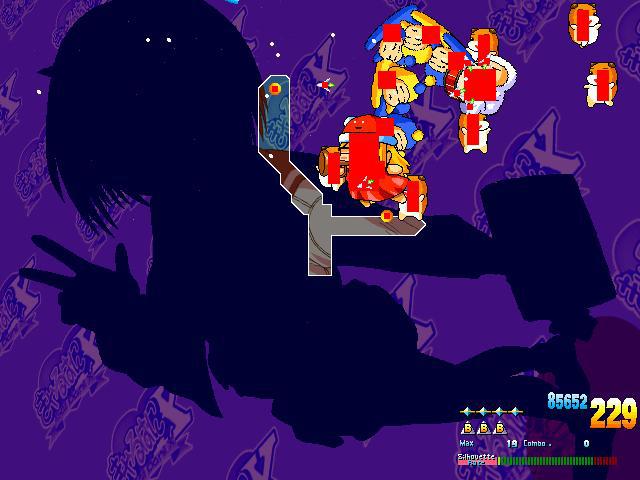
The first stage is fairly easy with practice, but I may have just died here. Note how the status box moved because of the player is in the upper left corner, where it usually goes.
The Screen and Onscreen Displays
Gal Pani X puts a lot of info into the status display on screen. First, the game displays your current life and bomb counts, of course. Your score is also on screen, and also your time remaining. The game also tells you your current Combo and max combo you’ve gotten during the current stage; combos build as you grind against edges of enemies or bullets, remember. One other meter is vital, the red and green bars which show how much of the screen, and of the hidden picture, you have revealed. Bright green boxes represent revealed parts of the portrait; dark green, unrevealed parts of the portrait up to the percent needed to clear the stage at a minimum percent-completed bar; and red, the parts of the portrait beyond that limit. Once you hit the red the stage ends, you win. To get 100% you must surround the entire red area at once.
If you hit ESC on the keyboard or a button on your gamepad (it’s on button 3 or 4), a pause menu appears. Here you can quit to the menu, take a screenshot of the current screen if you have unlocked this option, and retry the stage if you are in Mission or Score Attack modes. You can also save replays of levels after beating the stage if you wish, a nice option.
While playing the game though, it can be hard to keep track of everything that’s going on on screen at any one time. YOu will often have your little marker; perhaps a line, if you’re off of the revealed area; a large, colorfully-drawn boss; five or more regular enemies; and a screenfull of bullets, lasers, and missiles, all at the same time! You’ll just need to get used to the chaos with practice. The game will move the status box into the opposite corner if you are in the area it usually displays, though; that is helpful. But beyond that, memorization really is key. You will need to learn how each boss fights, which attacks it will use, and such. There are a wide variety of attacks, and each requires different strategies to dodge the bullets. Sometimes you have to carefully weave through waves of bullets, other times just get out of the way of a giant laser blast, and others keep moving as a homing missile tracks you, for instance. While bullets are on screen you should not leave the revealed area unless you are VERY sure that they won’t touch your line, of course — remember that if a bullet touches the line, you lose a life and your speed powerups go flying.
One important suggestion I have is to enable the option that shows all hitboxes. You can’t do this at the start of the game, but instead unlock it, I think by beating the game and such, or maybe through play time. Once unlocked, it’s great! This option significantly affects the graphics, as it draws bright solid red boxes over the middle of every sprite covering over the great sprite work, but the benefit is that now you will have no more guesswork, no more of those times where you say ‘but I thought I was safe there’. I usually play with this option on; I’d rather know where the hitboxes are than see the nicer graphics. This may be an option you have to unlock, I should note, but once you do unlock it, I highly recommend playing with it on for at least a while. It’s a HUGE help. All of the screenshots in this review have this on because that’s how I play the game, even if it looks worse.
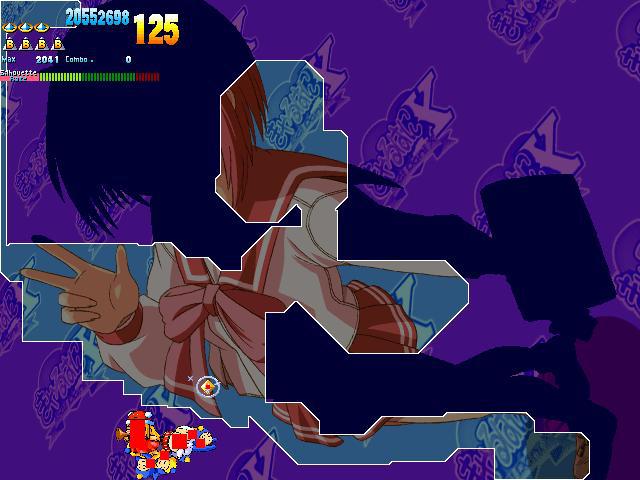
Here I am ready to make a line around the edge and get 100% on stage one!
Game Progression
With only six or so stages per game Gal Pani X is short, but the length works well in that classic arcade way, and the difficulty curve is well designed. Also, you can play more than twice that number of levels if you get 100%-portrait-revealed scores, as I will explain. The early stages are easy, but the last ones, particularly if you’re going for 100% clears, get quite tough. There is also fantastic replay value here thanks to the games’ branching level tree and numerous unlockables to get. You start from one start point, but after each stage you have two choices, so there are at least six different final stages, and then a whole bunch of bonus final stages to unlock if you’re good enough.
There are three ways to beat each stage. First, as in Qix, you can surround the boss with a line. If you do this you win immediately. You can also win by revealing 80% of the portrait, helped by paying attention to that red and green meter mentioned earlier. However, Gals Panic games have a second way to win: by revealing 100% of that character image on the screen. In order to do this you will need to corner the boss in some corner of the screen that isn’t part of the background portrait, because you can’t reveal the area underneath the boss itself. This isn’t hard at first, but gets difficult as you progress in the game and the portraits take up more and more of the screen. You’ll have to try to corner it against a wall in the largest sliver of free space you can find, and then carefully slice off any bits of picture still in the area. Of course bosses often seem to love to stay right exactly on top of teh exact spot you need them to leave… argh. That’s fine though, that is what makes the game a fun challenge. Then, in one go, make a line around the rest of the screen, and if you did it right and didn’t miss anything you will reveal the whole rest of the picture at once and get a 100%-revealed note.
If you got 100% of the picture in a stage, instead of moving to the next stage you go to a second bonus EX level on that stage. EX stages are a bit harder than regular ones, with pictures that take up more of the screen and thus are harder to 100% complete. They also usually have skimpier pictures of the girls, for better or worse. If you can manage to stay alive, playing twice as many stages will allow you to get a much higher score than you would get otherwise… but of course, the challenge there will be staying alive. This game isn’t too hard at first, but the last few stages on many routes get very challenging. I think I’ve beaten the game before without dying, but I don’t know how many 100% stages I went through in that run. After beating all of the regular stages, there is usually one final special level before the credits. Or at least, if you did well there will be. I’m not sure how the game determines which one you get, but it’s probably based on your score, whether you have continued, the route you took, and such. There are a lot of stages that you can only see as these final special levels, so a lot of replay is required to get everything in this game.
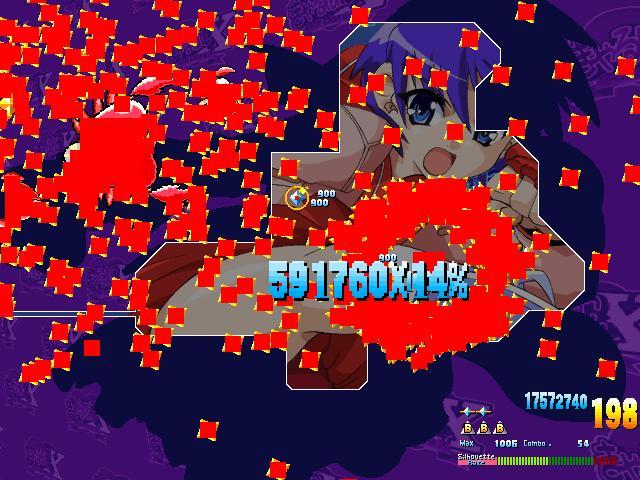
Here I just used a bomb to wipe out a screen-full of bullets. The number on screen is, I think, something showing the multiplier I got for a combo which just ended. How combo bonus multipliers work I don’t know, but wish I did.
Scoring
On that note, the scoring system is somewhat complex. You get points based on how fast you beat a stage, the completion percentage of both how much of the portrait you revealed and also how much of the whole screen you revealed (this second one cannot be 100% because the boss takes up space, but the higher the better), and such, but you also get points for Combos. The aforementioned combo meter builds as you graze against the edges of enemies or bullets or grab those point stars, and then resets to zero as soon as you stop doing so. There is also a bonus multiplier for longer combos, though I’m not sure exactly how it works; the instructions, such as they are, ARE all in Japanese, after all, and no English-language websites go into any detail about this game. The screenshot above shows that there are indeed multipliers, though. Of course, you can see your current and best combo on screen in the status area. Anyway, grazing enemies or bullets will get you points. You need to be close enough to touch the enemy sprite, but not close enough to actually be hit by it. Having the red hitboxes on makes this task easier.
Also, every time you kill an enemy or set off a bomb the size of the point stars gets larger and the number of points you get for each one increases. At the same time their speed increases as well though, so getting a lot of them at the higher speeds can be difficult if it’s from the circles shot out by defeated enemies. It does make it easier to get lots of points from using a bomb, though… so long as you stay alive; if you die, the size resets to the minimum. As a result you need to stay alive to get a high score. In addition you have a few second at the end of each stage to try to grab a few of the point symbols the boss spits out, but you only can reach any if you’re close to it. As a final note on scoring, again, there may be more to the combo system that I do not fully understand. I wish the game had English-language instructions, this is the one thing that I need help with. I know about the larger point totals if you stay alive and kill enemies, the increasing bonus points from edging bullets, and such, but I’m not sure I entirely get the point and combo system, though I’m not one who focuses on that kind of thing in shmups most of the time, so I don’t mind this really, it’s just a little bit confusing at times.
If you get game over and continue, it’s important to note, your score is reset to zero and you CANNOT enter it in the high score table. You can only enter a score if you either choose to not continue, or beat the game and have a score high enough to be on the table. I wish that scores from when you continue could count for the high score table, but they don’t. Ah well. My best recorded score is a bit over 22 billion, and I’m sure better players could do much better than that. Yes, you get a lot of points in this game.
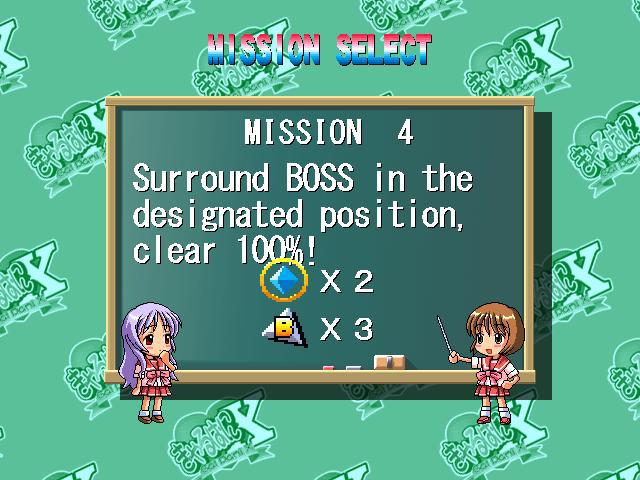
… This might be difficult…
Modes and Options
First, do remember that you don’t hit a button to get to the main menu. Once the game starts up, you can hit a button to skip the D5 company logo screen, but once the game title screen appears, don’t touch anything or you will start a game! Instead press down to select a different option, if you want to play something other than the main game.
The main gameplay mode here is selected with the top option, Game Start. This is the normal game, where you start from the beginning stage, with a background image of Akari from To Heart, and then go through the branching tree to whichever end you reach. You have infinite continues, but cannot save a game in progress to continue later. Any pictures you get 100% on are added to the Collection menu below. The game also keeps track of your best scores, play time, and more; see below.
Second is Mission mode. Here you have a specific goal to achieve. You must beat each mission in order to progress to the next one, and these missions are HARD! I did beat the first mission years ago, after many tries; you have to beat a challenging stage. The difficulty goes steeply up after that. It was only just before posting this that I finally managed to beat the second mission, which requires you get a combo score of 20,000, a very difficult task; I had to corner the enemy in a very small area and stay right next to it, hoping it wouldn’t kill me too many times. After that mission 3 is easier, just survive 90 seconds against lots of bullets. Mission 4 is hard again though — you have to corner the enemy in a very tiny little area marked on the screen, and get a 100% score as well. That’ll take a lot of practice to get right! Overall Mission mode is cool and very difficult, but I do wish that you didn’t have to beat each mission to see the next one — a design which let you play them in any order, like the combo or move challenges in some modern fighting games, would have been great here. From watching the menu-screen demo I know that there are at least 24 missions, so there is a LOT more of this game that I haven’t seen but badly want to! The rest of the missions, and the remaining secret stage backgrounds I haven’t gotten yet, are the main things I haven’t done yet with this game.
The third option is Score Attack mode. This mode will appear once you beat stages in Game Start mode. Here you can play any stage you have completed in the game, so this is a one-stage mode, for if you don’t have time for a full game and don’t want the challenge of a mission. The game has a separate high score table for each stage you’ve unlocked in Score Attack. Unfortunately, the names for all of the characters and stages here are in Japanese even when the game is set to English-language menus, so I don’t know who the non-To Heart characters are.
Next is Ranking. Here you can view your high scores in each mode, both for the main game and for each stage in Score Attack. Some mode names are in English and others Japanese, and others a mix of both. Heh. The game saves the top 10 scores for each table.
Following this is the Replay menu. Here yo ucan watch replays if you have saved any during or after a stage.
Next is the Config menu. This menu has three panels, for Game Setting, Sound Setting, and Display Setting. Here you can change the base game difficulty, turn on or off the floating menu (so it moves away when you go over it, I like this), turn on or off a FPS counter, set the number of lives you get per game, and set audio volume settings and such, and more. One nice option is Inst Skip, which skips the intro screen telling you how to play, unnecessary once you’re used to the game. Setting Inst Skip to On is a good idea, once you know how to play. There are two more options on the Display Settings screen that you will have to unlock, Hit Disp and Language. Hit Disp is the most important of these; I mentioned it earlier. This enables those solid red boxes over each sprite’s hitbox. Definitely check it out once you unlock it, it’s very useful info to know even if it covers over the sprites. And second is the Language setting, to switch between English and Japanese menus.
Finally, there is the Collection menu. This menu has five sub-menus, once you have unlocked them: Graphic, Music, Attack, EX Config, and Ending. Graphic allows you to view any of the background images in the game that you have 100% completed. Even though I have completed almost all of the regular stages in the game on all routes I’m only at 53%, so obviously I’m missing a lot of those special final bonus stages at the end of the game, or something like that. I presume a LOT of replay, on different routes and with good scores, will be required to get all of the images. Music is a music test, of any music you’ve heard. Attack records how many of the various boss attacks you have seen while playing the game. I’m in the 80-percent range for this one, so I’ve seen most boss attacks, but not all of them. You can’t actually watch the attacks here, unfortunately, only look at small pictures of them. Ending lets you view any endings you’ve seen. I have gotten two, the Good and Bad Endings. They are quite similar, but have different music and show different stages on the side of course, as the credits scroll. I do wish the endings were more different, but maybe there’s some secret one I don’t know about? Who knows. As for EX Config, these unlock as you play. At the point I am at in the game, I’ve got five things in this screen. It’s not interactive, it just shows what hidden options you have unlocked. First, and everyone has this, you will find your total play time (over 33 hours, for me). Next, there’s the ability to take screenshots in the game from the pause menu. Then after that I unlocked the Hit Draw option, which makes that Hit Disp option appear. Next is Free Shot, which will save a screenshot to a file whenever you press F11, for even easier screenshotting. Nice! And last is Language, to change the display language between English and Japanese. I think English is the default, for whatever reason, in this Japanese game, but regardless you can change it if you want.
And last, you can quit the game with Exit.
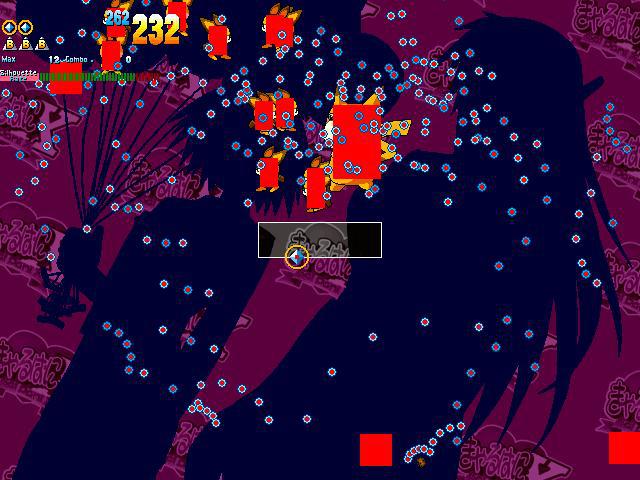
One of the last levels, as the enemy opens fire early in the stage. Dodging everything will be difficult. Also note how much of the screen is taken up with the portrait — getting a 100% will be hard, you’ll need to corner the boss in a small area.
Conclusion
Overall, Gal Pani X may be a visually risque game, with dozens of images of scantily-clad anime schoolgirls (though it has no nudity, at least), but the core gameplay beneath that iffy exterior is fantastic and extremely compelling. I would never still be playing this game once in a while, or be writing this review, if the actual game here wasn’t good… but it is, it’s really good! It really is true that whenever I play a Qix-style game, I think ‘this is fun… but Gal Pani X is better’. Being able to move around inside of the filled area is such a fantastic feature that I don’t understand why other games in this genre haven’t copied it! And yet, as far as I know, this is the one and only Qix-style game ever to do this. It’s crazy. The bullet-dodging mechanic this allows is also a great addition which makes the already tricky core gameplay even more challenging. Qix had a very good concept, and this game evolves on that idea in ways which make it better. I do admit that it helps that I like the To Heart anime, the game that makes up so many of the sprites and backgrounds in this game, but still, I am certain that I would love this game regardless of what the theme was. The core gameplay is exceptional.
For criticisms of the game, really I have only two — I wish there was a game like this but without the anime-girls-in-underwear artwork, and I wish there were better English-language instructions particularly for the combo system. I could make some other minor complaints, such as that the amount of replay required to get everything is a bit more than I’ve ever wanted to deal with, but that’s only an issue if you must collect everything you can in the game. I don’t mind not having all of the unlockable images and such, myself. I like the game enough to play it for over 30 hours, but not to play it enough to get everything. But for issues that’s really about it, though. I guess I could also complain about not knowing exactly what to do to get the numerous remaining stages, but I don’t mind that honestly; just keep playing and do better and you WILL see different final stages, so I know what to do, I just didn’t keep playing long enough to get everything. Anyway though, otherwise I love this game. The game has good sprite art, well-drawn backgrounds (where ever they came from), good, very responsive controls, huge amounts of replay value thanks to the unlockables and branching level tree, a high but approachable difficulty level, and, above all, great gameplay. Sure, I first played Gal Pani X because of To Heart, but I found one of the best freeware PC games around. I give Gal Pani X an A-, and it borders on a low A so it might deserve an A. It is a quite good game I definitely recommend. This is a unique game which puts a new spin on an arcade classic and improves it as a result. I’m still waiting for a Qix-style game better than this one. (For those who can’t stand the visual themes, and I can certainly understand why someone would think that way, if you like this kind of game at all, at least try it for the gameplay! That is the focus of the game, and it’d be a shame to miss out on this game because of the graphics.)
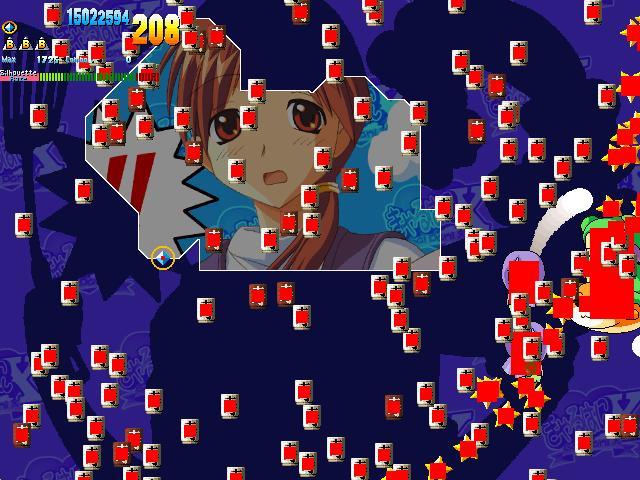
This bullet pattern is interesting — a lot of things drop from above, and you’ve got to move left and right to stay away from them.
Links
http://d5-dot.net/ was the developers’ website. It is now gone from the internet, and isn’t archived on web.archive.org. Argh.
http://www.ricedigital.co.uk/doujin-classics-sispri-gauntlet/ has a nice review of the developers’ other game, Sispri Gauntlet, from someone who actually has the full version of the game.
http://games.softpedia.com/get/Freeware-Games/GalPaniX.shtml – Here is one of the few sites with a download of the game which isn’t a sketchy “abandonware” site full of downloads for licensed games. The download here works great, so download, unzip (this game doesn’t install, it’s just a folder; run GPX.exe to play), and play the game!
Most English-language websites which mention this game are abandonware sites; they’re easy enough to find in a search, but I’d rather not link such things.
Oh, I do have a copy of that earlier 2000 demo version; I’m not sure how hard that is to find on the internet now that D5’s site is dead, the sites I saw only seemed to have the final game.

Amazing review. I thought I was the only person to remember this game! I wonder if it could be modded to remove the gals?
Also, the D5 website is now on archive.org – they seem to add additional data over time https://web.archive.org/web/20070114031147/http://d5-dot.net:80/gpx/index.html
Also, archive.org now has the D5 website!
I think I find the D5. website, but I don’t know if I can share link (^^;